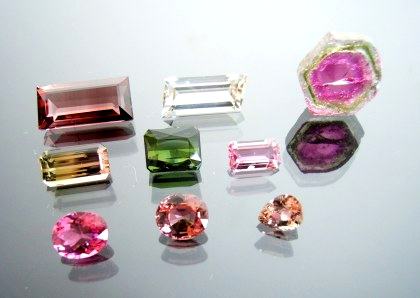 |
| 1.43 - 13.58ct |
ナイジェリアのトルマリン
(Nigerian Tourmaline)
 |
| 1.43 - 13.58ct |
13.58ct 20.00x10.00x6.60mm 4.28ct 12.80x6.90x5.30mm 8.60ct 20.40x7.90x6.30mm 0.62ct
5.2x5.2mm1.00ct
7.5x5.5mm0.52ct
6.0x5.6mm13.28ct 19.0x18.0x3.80mm Nigeria (詳細な産地不明 : Detailed localities unknown)
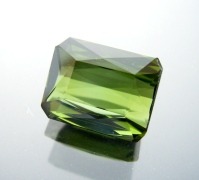 |
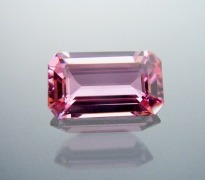 |
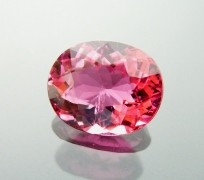 |
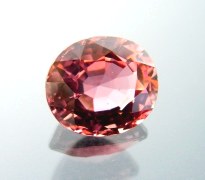 |
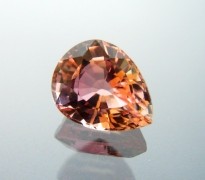 |
| 5.88ct 10.60x8.40x6.60mm | 1.86ct 10.0x6.0x3.7mm | 2.46ct 9.4x7.8x5.2mm | 2.40ct 8.9x7.8x5.2mm | 1.43ct 8.0x6.3x4.3mm |
| Nigeria | Oyo, South-Western Nigeria | Keffi, Central Nigeria | ||
ナイジェリアは金、錫、ニオブ、タンタル等の金属と共にトパーズ、緑柱石、ジルコン、トルマリンを産出します。とりわけ包有物が少なく、透明度の高い多彩な色合いのトルマリンはブラジル、マダガスカル、モザンビークと並んで最も重要な産地です。
2000年以降、パライバ・トルマリンの発見で世界の注目を集めましたが、2008年末より中央部のケフィ近郊でサファイアを思わせる輝かしいパステル・カラーのトルマリンが発見されました。
また南西部のオヨ渓谷からも2009年半ばに素晴らしく透明度が高くバブルガム・ピンクと呼ばれる鮮やかなピンクのトルマリンが発見され、市場に登場し始めました。
In Nigeria, gem tourmalines are mined together with topaz, beryls and zircon, in gold, tin, niobium and tantalum mining area in alluvial pegmatite zones.
Highly transparent and colorful tourmalines, reported from various places in Nigeria since late 1990's are comparable to Brazilian, Malagasy and Mozambique one, both in volume and quality. Followed by the discovery of Paraiba-type tourmalines in 2000.
日本の面積の2.5倍に相当するナイジェリアの92万平方kmの広大な国土の大半は前カンブリア紀後期から中生代の白亜紀にかけて太古の安定陸塊に貫入した花崗岩の岩盤が風化したペグマタイト性の土壌に覆われています。前述の金属資源や宝石はいずれも簡単な露天掘りで採掘されています。
Most of vast Nigerian land is covered with wheathered granitic pegmatite, which has undergone late precambrian to early palaeozoic orogenesis. Mineral resources and gems are recovered through simple open pit mining.
宝石質のトルマリンは主に三つの地域で採掘されています :
1.中央部のジョス (Jos) 高原周辺のザリア (Zaria)、アブジャ(Abuja)、
ケフィ(Keffi)、バウチ(Bauchi)
2.最東南端のカメルーン国境に近いカラバール(Calabar) 周辺
3.最西南端の首都ラゴスの北東100km余のイロリン(Ilorin),
オグボモーショ(Ogbomosho), オヨ(Oyo) 周辺
恐らく将来も新産地の報告が期待できるでしょう。
Gemmy tourmalines are mined mainly in three areas :
1.Jos Plateau (Zaria, Nassarawa, Jemaa) to eastern Bauch Plateau
2.South-Eastern area : Carabar near Cameroun border
3.South-Western area : Edeko near Ilorin
Considering the huge potential, there will be another discoveries of new deposits in the future.
ナイジェリアのトルマリンの特徴(Gemological charactors of Nigerian tourmalines)
ナイジェリアでは1980年代半ばから宝石質のトルマリンの産出が報告されています。
他の産地と異なり、包有物が極めて少なく透明度が高く多彩な色合いを持つこと等、際立った特徴があります。詳細な分析の結果、一般に宝石質のトルマリンの大半を占めるエルバイト・トルマリンのナトリウムの一部がカルシウムに置き換わったリディコート・トルマリンの比率が高いこと、またX軸に含まれるナトリウムとカルシウムとが欠落したロスマナイト・トルマリンが多色のトルマリンの無色の部分に含まれること、さらにブラジルのパライバ産のトルマリンと同様に銅とマンガンによる輝かしい青、緑、紫がブラジルについで発見されたこと。発色に影響は与えませんが、パライバ産と同様にビスマスを含むこと等の特徴を持つことが明らかになりました。
さらに分析の結果では鉄やチタンの含有量が低いことが明らかになっています。透明度の高いパステル・カラーや無色透明なトルマリンが多いのはこのためでしょう。
リディコートタイト、ロスマナイトとエルバイトとは精密な成分分析をしない限り、外見や色合い、比重や屈折率等では識別が出来ません。
Nigerian gem tourmalines were reported since mid 1980's and is known for it's high transparency and rich colors.
These characteristics were revealed through detailed analysis as follows ;
High percentage of Nigerian tourmalines are liddicoatite, of which Natrium in X ax is replaced by calcium. Rossmanite is partly included as colorless part in multi-colored tourmalines. It is possible to separate liddicoatite and rossmanite from elbaite only by accurate chemical composition analysis, and not by color, specific gravity nor refractive index.
Bright neon blue, green and violet tourmalines were reported as the second locality of Paraiba-type tourmaline, that contains copper and manganese. Although not coloring agent, high bismuth-bearing liddicoatite are reported from Nigeria.
Chemical analysis revealed that iron and titanium impurity is low in general, which results in highly transparent colorless and pastel-colors in Nigerian tourmalines.
ナイジェリア各地のトルマリン(Tourmalines from Nigeria)
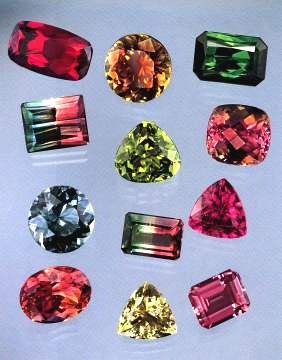 |
 |
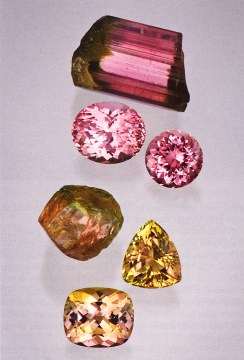 |
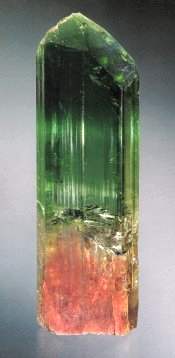 |
| 8.64ct | |||
 | |||
| 6.89ct | Top Crystal 31.6mm | ||
| 3.43 - 9.65ct | Liddicoatite | Faceted stones 6.71 - 16.82ct | 12.5cm |
| ナイジェリア各地のトルマリン (Various localities of Nigeria) |
Abuja | Keffi, Central Nigeria | Jos Plateau |
ナイジェリアの主なトルマリン産地の中で最もよく知られているのはジョス高原を中心に半径300kmに及ぶ一帯です。アブージャから東南東へ100km余り、ジョスから南西に200kmにあるケフィ近辺は1980年代半ばから透明度の高いトルマリンを産していましたが、2008年末に新たな鉱脈が発見され、サファイアを思わせる明るいパステルカラーのトルマリンが続々と市場に流入し始めています。
アブージャ産の紫色のトルマリンはリディコート・トルマリンです。
The most well-know Nigerian touramline locality is in Jos Plateau area. Keffi area, located 100km east-southeaste from Abuja and 200km south-west from Jos, has been produced gem quality tourmaline since mid 1980'. And in late 2008, there was a new find of elbaite, near the village of Akwandoka.
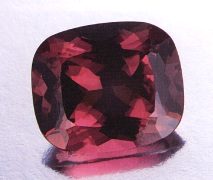 |
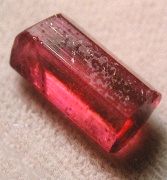 |
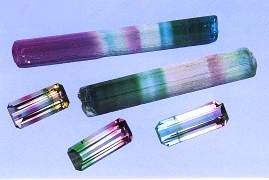 |
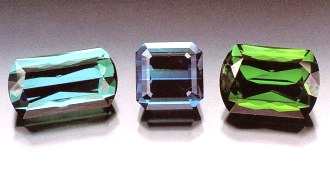 | |||||
| リディコート・トルマリン(Liddicoatite touramlines) | Elbaite tourmalines | |||||||
| 21.10ct |
Crystal 5.87ct 10x6mm |
Faceted stones :
1.39-1.70ct Crystals : 5.82 & 10.06ct |
9.50ct | 7.0ct | 9.5ct | |||
| Ogbomosho near Ilorin | Ibadan area | |||||||
| South-Western Nigeria | ||||||||
 |
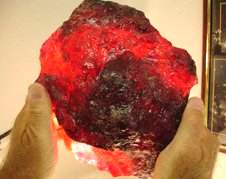 |
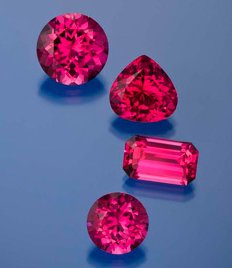 |
 |
| 1998年発見のトルマリン (1998 discovery) |
2009年発見のトルマリン (2009 discovery) | ||
| 左端の結晶(left crystal) 49x13.5mm | 7kg 28x13cm | 6.48 - 12.75ct | Leather mining
camp Abudja |
| Ogbomosho, Western Nigeria | Oyo Valley, South-Western Nigeria | ||
ベニン国境に近いナイジェリア最南西端のイバダン、オグボモショ周辺からは素晴らしく透明度の高いパステルカラーや多色のトルマリンを産します。オヨ渓谷からは1990年代後半よりピンクのトルマリンが報告されていましたが2009年半ばに新たな鉱床が発見されました。写真は9kgもある結晶とカットされたバブルガムーピンクと称される素晴らしくきれいなピンクのルースです。オヨ渓谷の新産地のトルマリンは包有物が少なく、やや紫を帯びた赤(40%)、濃い赤(10%)、バブルガム・ピンク(40%)と、魅力的な色合いの石が15%もの異例の高い歩留まりで得られるのが特徴です。
エルバイトのほかにリディコータイトや、多色のトルマリンの無色の部分のロスマナイト等、他には見られない成分比を持つトルマリンが採れるのが特徴です。
South-Western part of Nigeria, near Bennin boarder, Ibadan and Ogbomosho area near Ilorin, are another important gem tourmaline localities in Nigeria. Highly transparent pastel color and multi color tourmalines (elbaite, rossmanite and liddicoatite) are recovered. Rare colorless rossmanite part is seen in multicolored tourmaline.
Quite recently, in August 2009, a significant deposit of pink to red tourmaline was found in Oyo Valley, near Ogmobosho. A 20kg of parcel obtained in August was notable for its high transparency and bright colors : slightly purplish red(50%), darker-red(10%) and "bubble-gum pink"(40%). Cutting the stones into relatively few inclusions resulted in an overall yield of approximately 15%. The deposit shows good potential for additional pink-to-red tourmalines for the jewelery market.
パライバ型トルマリン(Paraiba type tourmalines)
| 2001年発見(2001 discdovery) | |||
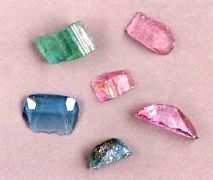 |
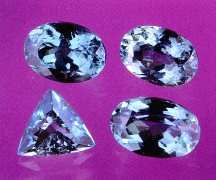 |
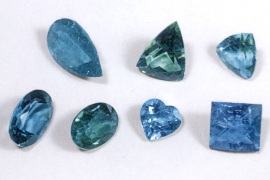 |
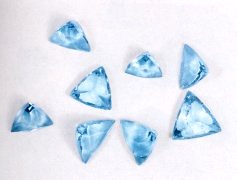 |
| 0.69-1.44ct | 0.77 - 1.10ct | 0.34 - 2.45ct | 0.28−0.43ct |
| Edeko, near Ilorin, South Western Nigeria | Ofiki area, near Ilorin | ||
2007年発見(2007 discovery) 1989年のブラジル北東部のパライバ州での発見に続き 2001年にナイジェリア最西南部のイロリン近くのエデコとオフィキの2地域から相次いで銅とマンガンを含むトルマリンが発見されました。オフィキ産は銅の含有率が低く淡い色でしたが、エデコ産の石はブラジルと比べて全く遜色のない品質でした。が、ナイジェリア産としてではなく、大半がブラジル経由でパライバ産として市場に流通していたと言われます。
その後2007年に新たにパライバ型のトルマリン産地が報告されました。新しい産地とのことですが詳細な産地は未だに不明です。色合いからすると二つの産地があると思われます。多色の産地のものはその後モザンビークで発見されたものさらにブラジルのパライバ産とも色合いがそっくりです。
ブラジル、ナイジェリア、モザンビークと、現在は世界の3ヶ所からパライバ型のトルマリンの産出があります。外見と色合いからは産地の識別は不可能でしたが、2006年になり、それぞれの産地の石に含まれる微量の銅、マンガン、ガリウム、鉛、ベリリウム、マグネシウムと亜鉛の成分比率を検討することで高い精度で産地の識別は可能となりました。0.31 - 1.04ct 6.35 - 13.92ct 産地不明(locality unknown)
Following Brazilian paraiba tourmaline discovery in 1989, Nigeria became the second locality to produce paraiba-type cuprian elbaite. It was discovered in the South-Eastern Nigeria at Ediko and Ofiki area, near Ilorin. Ofiki stones contain lower cupper and have pale color, while Ediko stones have same saturated color as Brazilian origine. Most of Nigerian stones were exported to Brazil and sold as Paraiba origine.
In 2007, tow new localities were reported, without exact locations announced. One locality produces lilac color stones and another multicolor stones, which terribly resembles that of Paraiba, Brazil and of Mozambique origines. In 2006, geochmical plots of CuO+MnO versus Ca+Pb, CuO:MnO versus Pb/Be, and Mg-Zn-Pb revealed that quantitative data for these elements might enables a reliable separation of Brazilian stones from their counterparts mined in Nigeria and Mozambique.
Top Gemhall